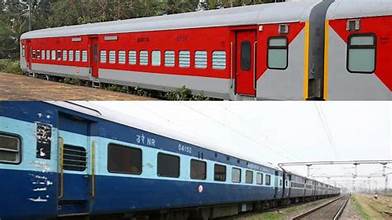Indian Railways, the fourth largest rail network in the world, is a lifeline for millions of people who travel daily across the diverse landscapes of India. A noticeable feature of these trains is the predominance of blue and red coaches. While the general and express trains are mostly adorned with blue coaches, the premium class trains like Rajdhani and Superfast have red coaches. This article delves into the reasons behind these color schemes and provides an in-depth analysis of the two main types of coaches used in Indian Railways – ICF (Integral Coach Factory) and LHB (Linke Hofmann Busch).
The Superiority of LHB Coaches
LHB coaches, compared to their ICF counterparts, are a more recent addition to the Indian Railways and are known for their enhanced safety and performance. Crafted with an anti-telescopic design, these coaches are less likely to crumple or pile up in case of an accident. Made from stainless steel, LHB coaches not only have a higher impact resistance in the event of a collision but are also lighter and have an increased carrying capacity. The coupling system in LHB coaches reduces relative motion between them, preventing one coach from mounting another during a crash. These coaches can maintain an average speed of 160 km/h and a top speed of 200 km/h.
ICF Coaches: The Traditional Backbone
Originating from the Integral Coach Factory in Chennai, Tamil Nadu, established in 1952, ICF coaches have been the traditional backbone of Indian Railways for decades. Constructed primarily from iron, these coaches are heavier and have a different braking system compared to LHB coaches. They require more maintenance, resulting in higher expenses for the railway. With a seating capacity of 72 in sleeper classes and 64 in third AC, these coaches are also 1.7 meters shorter than LHB coaches. A significant drawback is their vulnerability in accidents, where coaches tend to telescope. ICF coaches require periodic overhauls every 18 months and have an average speed of 70 km/h and a top speed of 140 km/h.
Lifespan and Utilization of Coaches
The lifespan of coaches is a crucial aspect of railway operations. ICF coaches, made of steel, have a codal life of 25 years, after which they are retired from passenger service. On the other hand, LHB coaches, made of stainless steel, have a longer lifespan of 30 years. This increased durability not only ensures better safety but also makes LHB coaches a more economical option in the long run.
Disclaimer : इस न्यूज़ पोर्टल को बेहतर बनाने में सहायता करें और किसी खबर या अंश मे कोई गलती हो या सूचना / तथ्य में कोई कमी हो अथवा कोई कॉपीराइट आपत्ति हो तो वह [email protected] पर सूचित करें। साथ ही साथ पूरी जानकारी तथ्य के साथ दें। जिससे आलेख को सही किया जा सके या हटाया जा सके ।















